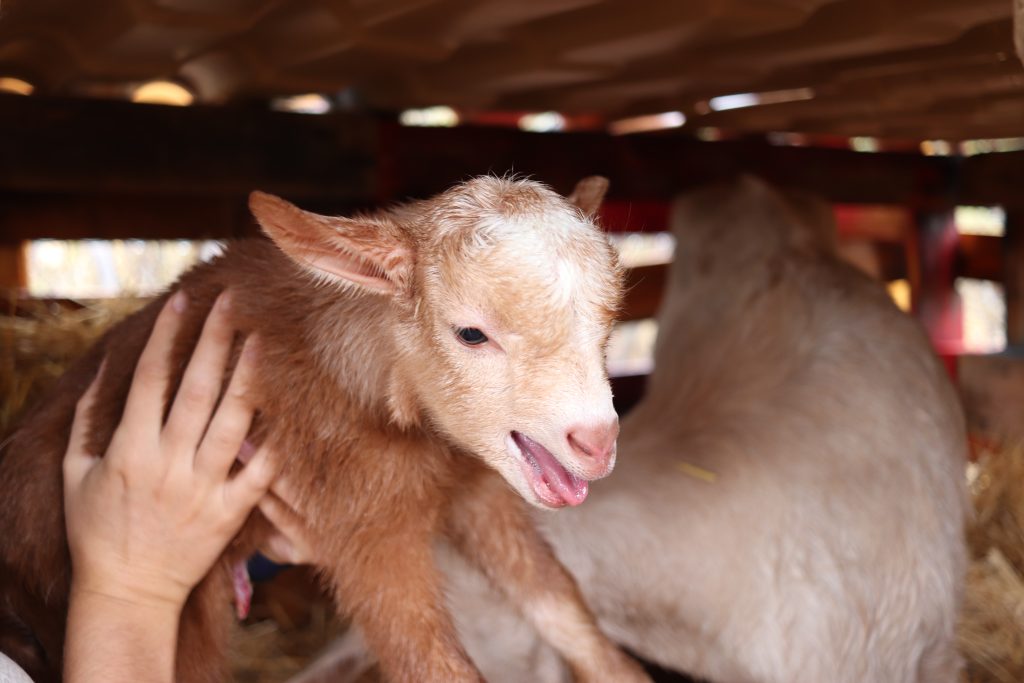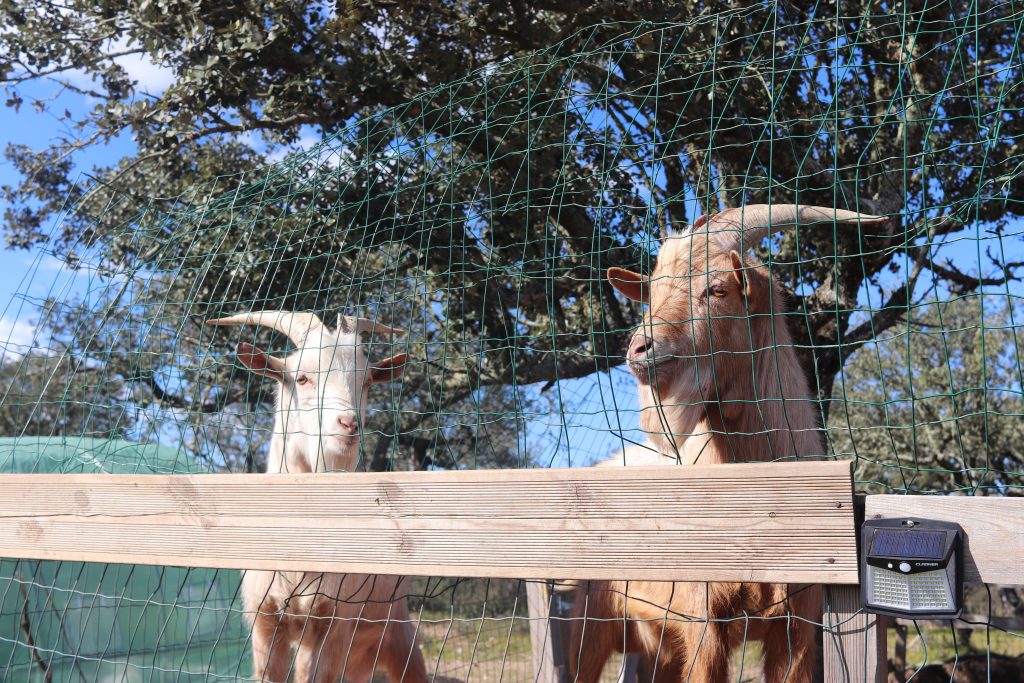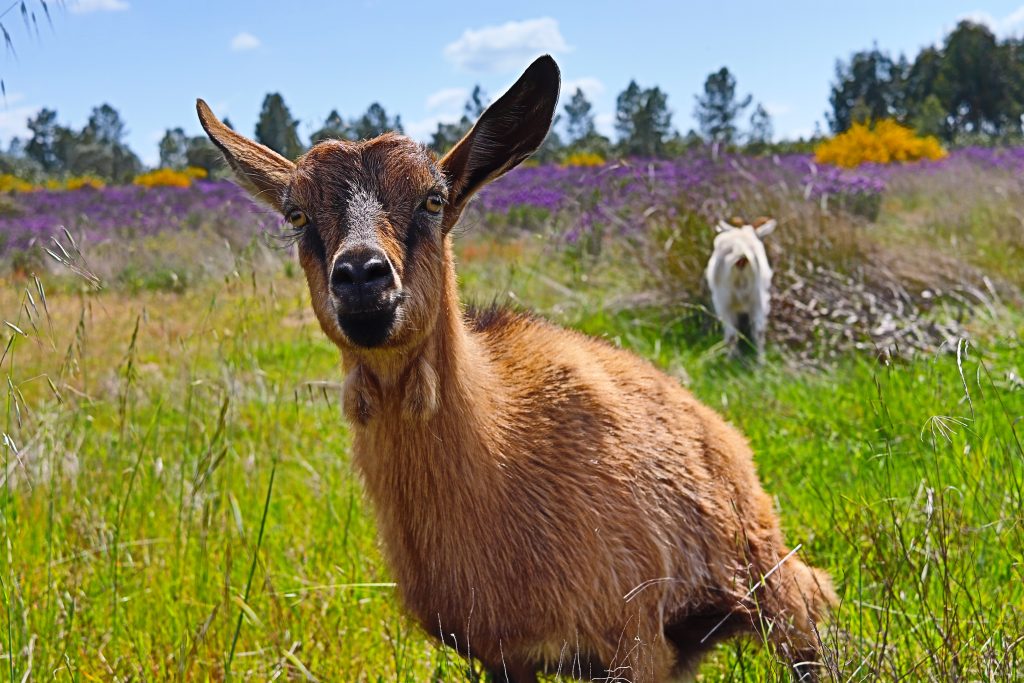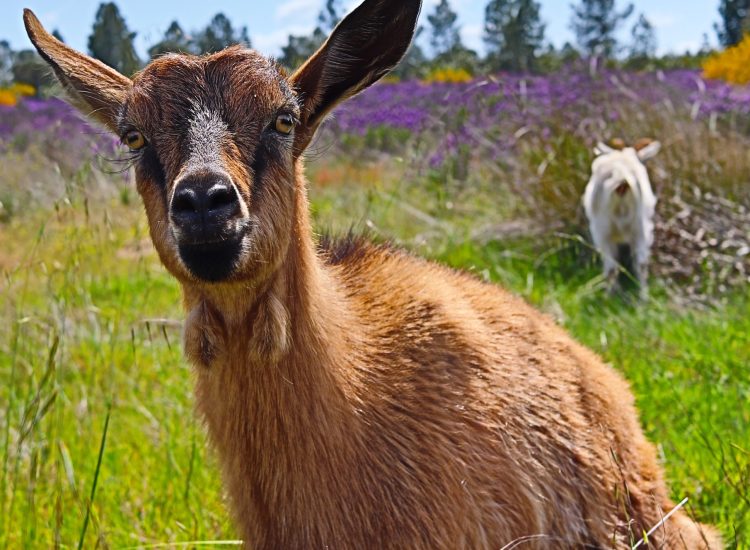The benefits of goats are many, from milk to meat to manure to brush-clearing.
In this post we’ll focus on the basics of raising goats, namely smaller breeds.
Picking The Breed
Choice was lacking for us when we first arrived Central Portugal, not having built up many contacts. We ended up with two Nigerian Dwarfs –crossed with something else– but these turned out to be the best beginner goats we could have hoped for.
The Nigerian Dwarf came out West Africa–unsurprisingly–and are prolific milkers. Ours, although crossed with some unknown breed, have indeed proved good milkers with us easily achieving 2L (8.5 cups) a day.
Their stockiness lends to a decent yield of meat, too, which I believe was their original purpose.
We managed to acquire a male a few months later, a stocky pygmy-type fella (though not anywhere near as small as the traditional American Pygmy), and the breeding games began.
Within two years, we grew our herd from three to seven.

Murcianas are our next venture, which is a Spanish dairy goat created in 1975 when two existing breeds, the mahogany-colored Murciana of Murcia and the black Granadina of Granada, were cross-bred. Today, Murciana is the most important dairy goat breed of Spain, with more than 500,000 milking females.
They’re easy for us to source, too, and cost just �40 for a young female.

Feed and General Care
If space allows, the healthiest (and cheapest) option is to have your goats free-range on natural grasslands, with the varied plant species that this provides. A varied diet is optimal — a healthy goat can’t be sustained on grass alone, they need dandelions, thistles, rose, horseweeds, lambs-quarter, ragweed, burdock and the like.
This doesn’t necessarily mean you need to construct a huge multi-acre enclosure. For us, we regularly let our goats out of their enclosure to wonder and graze around our 8-acres. They are very tame, too, and will come when called. They are very sociable animals, and will often follow us around, which to be honest can be annoying.
In order to let our goats roam we constructed strong fences around our vegetable patches.
Also, their enclosure is pretty large, and is split into two — half of the year the goats are locked in one section, while we grow crops (such as corn, wheat and sorghum) in the other, and then we rotate, i.e. the goats are allowed into forage on the stumps of the harvest crops, while we begin growing in the first section.
This works great: the goats clean up the residual crops for us (free feed) while simultaneously fertilizing the soil for the next planting (we do the same with the chickens, guineafowl and pigs, too).
If feeding ‘traditionally’, goats require a constant supply of hay.
And be sure to feed them quality, ideally non-GMO feed (if you want the highest quality, safest products).
Basic Healthcare And Upkeep
We have found goats to be nowhere near as high maintenance as the interweb led us to believe. They are not escape artists (pigs are!), nor are they all-that noisy (unlike guineafowl!).
Saying that though, issues can of course still arise.
Toenail trimming is an important task.
One of our females got a pretty bad case of foot rot during a particularly wet winter. Cutting down a goat’s hooves can be done with just a simple set of garden shears, or even heavy-duty scissors so long as they’re sharp — though starter hoof trimmers won’t set you back much, see here.
Worming is another thing to keep on top of.
From experience, goats are very prone to intestinal worms.
I diagnose worms using the goat�s symptoms (such as weight loss) and also the FAMACHA chart:

Very simply, we’re looking at the coloring of the inner eyelids, matching it up with a scorecard ranking color on a scale of 1 to 5. A dark red eyelid membrane color is a 1 and indicates no significant anemia. A white color is a 5 and indicates severe anemia. 1 is good, indicating no worms, 5 is bad, suggesting a high parasitic infection.
Note: goats rarely produce a dark red (1) like sheep do — a ranking of 2 is perfectly acceptable.
We treat worms –or rather, prevent them from ever becoming an issue– by incorporating large volumes of pumpkins into our goats’ diet. Vine crops contain (primarily in the seeds) the deworming compound cucurbitacin.
Access to weeds and wild flowers on the grasslands also helps keep internal parasites down.
Worms were once a big issue for us, until we dedicated an annual pumpkin patch to our goats, which we feed to them over the course of the year–and also before we regularly allowed them out to forage.
Bucks And Breeding
Bucks are smelly and are easily excitable around females, let’s say…
Still, my favorite goat is our first born buck, “Junior”. We, with the help of “Mumma”, birthed him and raised him into a truly charismatic and friendly member of the family.
Junior is also now the leader of the herd, charged with looking after the others (as well as the poultry and pigs); the first to ward off any danger, which comes in the form of wild boars, foxes, Egyptian mongoose and eagles.

Unlike many of the larger goat breeds, Nigerian Dwarfs and Murcianas don’t come into heat seasonally, meaning they can fall pregnant at anytime of the year. When seeking to expand our herd quickly, this has proved beneficial. But there are times when we need to separate out intact bucks from the females, particularly in late pregnancy (to protect from miscarriages) and within the first year of birthing (to give the female a break).

We don’t need to be too concerned with winter kiddings in Portugal. While we have experienced -5C (23F) in the past, frosts and freezes aren’t generally a big concern, particularly given our sturdy shelters and plentiful bedding.
A Word On Milking and Meat
In order to produce milk, of course, your goat must be bred and have kids.
For more on milking your goats, click here:
Milking Goats
For more on processing your goats for meat (link coming soon).
To Conclude
Goats are a good and healthy source of milk, meat, manure, they are superb brush-clearers, and on top of all that they make great companions (for us adults as well as for the children).
After keeping these animals for some time now, nothing we have experienced has put us off. Quite the opposite. As mentioned earlier, we intend to continue expanding our herd with the addition of Murcianas.




Very interesting! Our neighbours are getting goats, so will watch with interest and possibly follow suit at some point.